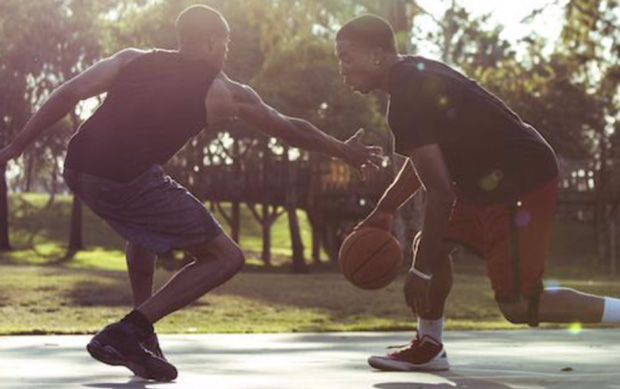| Why Basketball 1-on-1 Drills Are Ruining
Your Game |
| By: T.J. Allan
Provided by: STACK Practice, right? The more repetitions you get, the faster you improve. But is that really true? Can you really become the next Steph Curry by shooting 2,000 shots every night in your backyard? No. We're missing the second piece of the puzzle - quality. Shooting set shots in your backyard without a defense or time constraints won't cut it no matter how many repetitions you get. So, now for the real question. How do we get the most game-like repetitions during the off-season? Most would answer "playing a game." And that's probably why basketball has become a year-round sport. The assumption is the more games you play, the more quality repetitions you get, and in turn, the faster you improve. Unfortunately, that assumption is flawed. How many scoring opportunities does the team's best player get over the course of a game? 20 or 25 at most. How many scoring opportunities does the team's fourth and fifth best player get during that same game? Four, maybe five. Are five quality repetitions in a 40-minute game going to cut it? Is it any wonder that the best players on a team who primarily focus on games during the off-season continue to improve while the 4th, 5th, and 6th best players remain stagnant? So I ask again. How can we get the most game-like repetitions during the off-season? Basketball 1-on-1 drills, right? In a 5-on-5 game, you're competing with four other teammates for repetitions. In one-on-one, you're guaranteed to get a repetition every possession. That equates to 30 or 40 reps per 40-minutes game. Unfortunately, that's what most players do. They perform a few shooting and dribbling drills and then immediately jump into a 1-on-1 half-court game. Although it's definitely an improvement over 5-on-5, it's still not the best drill to improve the quickest. It lacks quality repetitions that could translate to a real game. How often have you seen a player in a 1-on-1 basketball drill spend the first 15 seconds of a possession dribbling through his legs without making a move? That very same player will then use the entire half court to get a shot off. Put that player in a 5-on-5 game using that same move, and he will completely slow down the offense. Using the entire court for his attack will lead to a wasted possession. Time and space mean very little in 1-on-1, yet they mean everything in 5-on-5. The very best basketball players attack within minimal time and within minimal space. A Skill Development Tool
Here is a basketball drill I spent the last five years searching for and testing. We have creatively nicknamed it "The Box." It's a 1-on-1 basketball drill, but it adds constraints for time and space. The Rules are Simple • It's full-court 1-on-1 but the court is only 10 feet wide and 35 feet long. We simply took the width of the court and divided it by 5 players. A good offensive player should be able to score anywhere on the court, even under his own basket. Players are engaged as soon as they step inbounds. • There is a 6-second shot clock for each possession, thereby ensuring there are no wasted dribbles or moves. • All points are worth 1 point. • If you're fouled at any point, it's an automatic point. If you make the basket and get fouled, it's 3 points. • Defensive players call fouls. • The possession is over if a player shoots it, loses the basketball, goes out of bounds, or the 6-second shot clock expires. There are no offensive rebounds or second chance points. • Depending on the players' fitness level and the goal of the drill, games are between 10-40 repetitions. Why is this Basketball Drill so Effective? • Every possession is a quality repetition. If we agree that the more quality repetitions a player gets, the faster he improves, this drill is a recipe for success. • Time and space constraints are added so the 1-on-1 game becomes similar to a 5-on-5 game. There can be no wasted dribbles or offensive moves that use too much space. Players learn how to create scoring opportunities quickly, and in turn, they don't slow the offense down during 5-on-5 games. • The 3-point play encourages players to attack the hoop. During a traditional 1-on-1 game, too many players settle for 3-point shots or open jump shots. • Lack of a 3-point line encourages players to develop mid-range jump shots, which are desperately missing in today's game. • The space and time constraints force players to improve their dribbling. There can be no wasted dribbles or loose handles. • Keeping score adds a level of competitiveness most drills lack. Because of that, players never get bored or lose focus. In fact, most players want additional repetitions in the Box Drill because they love the competition. • There is little need for coaching. The best basketball drills force players to do them correctly without too many coaching cues. In this day and age, players don't have the focus or patience to listen to a 10-minute speech about a drill. With the time and space constraints in the Box, players get immediate feedback whether the repetition was good or bad. Waste too many dribbles and the shot clock expires. Use too much space during an attack and you'll find yourself out of bounds. The entire drill is focused on angles and efficiency without the players even knowing it. Because I'm a strength coach and skill development coach, I try to intertwine skills training with strength and conditioning as much as possible. Unlike professional athletes, high school and college athletes can't spend four hours in the gym every day. The Box Drill is a GREAT drill for agility as well as conditioning. Conditioning Tool No basketball player wants to spend 60 minutes on the treadmill or bike during a conditioning workout. It's too boring. Yet if a player isn't properly conditioned, his skills will diminish during the late quarters of the game, and he'll be putting himself at risk for injury. The Box Drill has been the best drill we've found for conditioning basketball players. Our players routinely wear heart rate monitors during the drill, and within just a few repetitions, their heart rates are up in the 90 percent max zone. We can tweak rest periods between possessions so that we put the players in zones that are particular to the sport of basketball. One last thing to consider regarding conditioning: Running and cycling primarily involve linear movements. Basketball is a game played in all three planes using various modes of movement—linear, lateral, forward, backward, shuffles, short sprints and drop steps. The treadmill lacks the specificity of the Box Drill for basketball players. Agility Tool A basketball player can spend an entire off-season performing ladder drills and 5-10-5 drills and see little, if any, improvement in his agility on the basketball court. Why? Because agility is more than just change of direction. According to Nick Winkleman, agility is the ability to change direction and react. Thus, the cognitive processes involved in making the decision to react to a stimulus are just as important as the actual movement involved in a change of direction. Research has continually shown that the most "agile" athletes in their respective sports aren't necessarily quicker than less agile athletes, but they are able to process stimuli faster, leading to a faster reaction. Someone like Serena Williams has returned tens if not hundreds of thousands of serves over the years. Her ability to react so quickly to a serve is not because she can run a great 5-10-5 but because her mind sees patterns in her opponents' serving motion that allow her to react quickly. She knows what to focus on, thereby blocking out distractions that cause a delay in her reaction. Because space in the Box Drill is limited and possessions are only 6 seconds long, a player is almost always reacting to a stimulus on the offensive and defensive ends. Thus, he learns to shuffle, drop step, and sprint in basketball-specific ways. Think about it. How many shuffles does a player perform during an actual game before he has to turn and sprint? Two? Maybe 3? Yet how many of the agility shuffling drills have an athlete performing 10 or even 15 shuffles before changing direction? Again I would argue it's an even more effective drill than 5-on-5 because during a game, a player spends a large amount of time jogging in a straight line. In the Box, very little time is spent jogging. A player is engaged as soon as he steps inside the box. Using the Box Drill A player may be tempted to use only the Box Drill during his or her off-season training. That would be a mistake. Because the Box is essentially a competitive game, players also need to spend time learning new skills, perfecting technique, and working on weaknesses. All of those things should be done during the beginning of the workout when fatigue won't interfere with learning. Typically, we start our 60-minute sessions with technique work for the shot, then progress to working on either adding a new skill (e.g., an inside-out crossover) or improving a weakness. Then we finish with the Box Drill during the final 15-20 minutes. One last important point to consider. Because the Box Drill is a competition, players tend to use moves that fit their strengths, and thus improvement slows. The Box Drill can be adapted to any player's weaknesses, thus forcing him to work on that weakness during the drill. For example, we have a high school guard who is a great outside shooter. He shoots a high percentage, has a quick release, and is above average in height for a guard, allowing him to get a shot off whenever he wants. This off-season, our focus is on turning him into a complete player by improving his attacking game. However, whenever we initially put him in the Box, he did what he does best, shoot from the outside, because he wanted to win. So we purchased a $100 portable rim that is of such low quality it makes outside shooting extremely tough. He immediately realized that if he wanted to win, he had to attack the rim, because the cheap rim was preventing him from being a knockdown shooter. After just 2 weeks of the Box Drill, he noticed an improvement during his 5-on-5 summer league games. Be creative and think outside the Box. |





